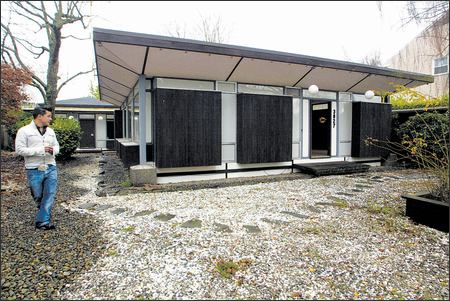Schwarz
View current page
...more recent posts
When the Ouroussoff article came out I had just made my second visit to the revamped MoMA. My first visit involved one of the many opening galas when, sometime late in the evening after several vodka and sodas, two self-proclaimed "bloggers" asked me how I liked the new building. I told them I loathed it. "What do you mean?" one sputtered. I couldn't articulate an answer, but what I meant is I hated the grandeur of the place, how much it seemed to celebrate not the art or the objects but the exalted cultural role of the institution.
On my second visit I made peace with the building. I still don't care for the bombast of the communal spaces, but I'm happy with the contents of many of the galleries, especially the smaller ones housing prints and drawings, architecture and design. Granted the design gallery is no longer a sparsely populated hideaway on the top floor of the museum. And I'm nostalgic about the days when I would have the collection all to myself, but the bigger, brighter space surely reflects the new status of design in American popular culture.
About that same time I was also thinking about how hard it is to mount a really innovative contemporary industrial-design show these days. The problem--and it's not specific to MoMA--is that the products one can find on the shelves of almost any store are likely to be as varied, sophisticated, and inventive as the objects a museum can pull together. Stores can change inventory faster and with much less planning than a curator burdened with two-year lead times. When I visit the Cooper-Hewitt now I spend more time in the shop than in the galleries. Director of retail Gregory Krum was once the product manager at Moss, a Soho design shop that appropriated the aesthetic of a museum design gallery. Because he is a merchant, Krum can put his ideas into action without sitting through countless committee meetings. As a result the store is generally a better place to view fresh design.
It may be true that talents like Ms. Hadid and Mr. Koolhaas have sucked some of the oxygen from members of a younger generation struggling to find their footing in a celebrity-driven profession. The jury is still out on that one. But either way, these buildings prove that architecture is in the midst of a renaissance. Whatever one imagines about the egos of their architects, these projects exude a social dynamism and freedom - a thriving democratic ideal.
What's more, such buildings force us to re-examine corners of Modernist history that once seemed relegated to the scrapheap. Their architects are clearly influenced by talents as far ranging as Kevin Roche, Hans Scharoun and Oswald Mathias Ungers, whose tough, sometimes brutal forms were once excluded from the Modernist canon.
The problem is how few people seem capable of such a generous view of history. Recent landmark preservation battles in New York suggest that the civic powers-that-be insist on defending a narrow view of the past and of Modernism in particular. That became apparent during the crusade to preserve Edward Durell Stone's so-called lollipop building at 2 Columbus Circle, a landmark of late Modernism, when the New York City Landmarks Preservation Commission refused to schedule a public hearing to consider its designation. As a result, the facade is being utterly revamped.
no top ten this year in memory of the town of my birth, new orleans louisiana
Can a mass-produced object become like an artwork? Die Welt's Uta Baier considers the question by looking at the recent legal battle over Marcel Breuer's B9 table, first made in 1925-26. As Baier reports, two German firms—Tecta and Knoll International—asked a Dusseldorf court to decide which company has the right to reproduce the table for the contemporary market. B9 has become a cult object because it is the first piece of furniture that Breuer made with steel tubes. (After experimenting with Duralumin pipes, a material used in the ‘20s in Dessau for aircraft construction, the Bauhaus architect decided upon steel tubing because it was cheaper.)
"The table's cult status means that a mass product became an expensive piece of design, a work of art that has stories to tell, justifying its high price," writes Baier. For the courts, the only story that counts is the contract that gives a firm the right to reproduce a design. While Breuer himself signed the contract with Knoll International in 1968, Tecta earned the right to reproduce B9 from Berlin's Bauhaus archive, which cooperated with Breuer's widow. As Baier notes, a lower court has decided in favor of Knoll because the company's contract is older. A higher court will decide the case on January 24.
“Entertainment is part of our culture, and as consumers of music we need to continue to support artists. Go out to a concert; on payday, go to your favourite music store and if you like that song that you burned off the Net, buy the album. As a creative city, let’s demonstrate our cultural values.”
What Galera’s letter to the editor underscores is a new reality for music lovers and the music industry: Buying an album is now a political act.
As with many contemporary thinkers, Eisenman rejects the redemptive notion of collective memory and its unexamined links to the sacred, which unite its celebrants in a reassuring cult of remembrance. Memorials, Eisenman has noted, are not about memory but about nostalgia. In this case, architecture becomes a hermeneutic, probing, questioning, withholding solace and thus closure. However challenged or troubled by the work, visitors are never overwhelmed nor reduced to anxious impotence. Nothing affects them without their active, willed participation. By avoiding an iconic design, Eisenman has ensured that the whole cannot be apprehended from any single vantage point. There is no center, no resting spot for the eye or the body, no therapeutic catharsis. The tight weave of the project never loosens its grip on visitors, or allows them to yield attention to apperception. They have to negotiate the narrow fissures between the somber stelae virtually in single file. Anamnesis becomes a personal rather than a collective endeavor, and the injunction to remember is left the responsibility of each individual spectator.

The Hurricane Katrina crisis began for Bruneau on Monday, August 29th, shortly after the storm had passed through. A young woman lay dead in the middle of the 1900 block of Jackson Avenue. Her skull was crushed, and a fallen street light, blown down by the ninety-five-mile-an-hour winds, lay beside her. Along Jackson Avenue, people were emerging from shotgun shacks into a world of smashed oak trees and downed power lines. Some of them knew the woman. She had gone out during the storm to buy drugs.
plastic fantastic

albini desk from retromodern
Television producers Bert Schneider and Bob Rafelson came up with the idea of casting a rock-and-roll band that could star in its own televison series on NBC. They ran an ad in Variety and selected four young men to serve as members of the band: Michael Nesmith, Peter Tork, Davy Jones, and Micky Dolenz. They produced a pilot and called the group the Monkees. It was Boyce and Hart who did the songs for the pilot in 1966, including the singing. When rock impressario Don Kirschner was brought in to handle the music for the show, he told Boyce and Hart they didn't have a proven track record as producers and they were off the project, except as songwriters. As the show's first air date loomed, one music producer after another was acquired and then rejected for the project, while Tommy Boyce kept telling Kirschner that he and Bobby could handle it. Kirschner finally gave them a chance, Boyce and Hart recorded vocals and backing tracks for the first album, and then the Monkees recorded lead vocals.

But there are plenty of buyers, with some seeking investments and others just needing a place to live after losing a home. Most people are buying "high and dry," to borrow the term on every broker's lips since Katrina, but even that seems a surprising vote of confidence in the long-term prospects of New Orleans and the surrounding parishes. In the West Bank area, which lies west of the Mississippi River, November sales were up 99 percent, in dollar terms, over November 2004, according to data provided by Latter & Blum. And in the high-priced Garden and Warehouse districts, the firm's November sales more than doubled.
stern strike fist
"anybody die yet?"

also available : dennis, jeanne, frances, ivan, charlie, floyd, gorges, rita, bonnie, fran, bertha, andrew...
Uncle Tom's Cabin will one day be open to the public.
The owner of an 18th-century Colonial in Bethesda, Md., listed a three-bedroom house and attached 205-year-old log cabin for sale for $995,000 in October. Josiah Henson, a slave who lived on the former tobacco plantation for 30 years, inspired the Uncle Tom character in Harriet Beecher Stowe's 1852 novel.
Located on a one-acre site surrounded by McMansions, the house was not protected as a local landmark, so Montgomery County officials sprung into action, raising money to match a $1 million offer. Owner Greg Mallet-Prevost, whose mother owned the house since the 1960s, accepted the county's offer on Dec. 23.
wfmu best of '05
find those dj's archives here
fluff desk: curbed 2005 awards
nyt architecture critic NICOLAI OUROUSSOFF was on charlie rose last night. I like this guy. among other things he called out daniel liebskind for not having the courage to walk off the job in protest.
sol moscot glasses for the masses
via zars

Former renter Stephen Busto put a posting in Craigslist and hosted two open houses to try to save a 1960s-era "flexible home" from demolition.
In a house with only one door inside, privacy has to be a shared concept. Especially when the door leads to the one bathroom in a 1,000-square-foot house shared by a family of four.
Close quarters by necessity is one thing, but this was by design. In the era of the 1962 World's Fair, the dream of a "flexible house" became a reality for commercial architect Robert Allan Adams.
Adams designed the Mount Baker house to efficiently accommodate and change with his young family. Post-toddler, a playpen set into a recessed area turned into a conversation pit in the living room. Beds folded up into movable walls. Interior partitions doubling as storage units did not reach the flat ceiling, creating Spartan but well-ventilated rooms. Features such as these made the 1963 house seem at once very retro and future-fantastic for the way the space flowed through multiuse areas.
Now the house and its nearly identical 350-square-foot guesthouse are in danger of vanishing from modern Seattle architectural history if they can't find a new home. The new owner of the 8,240-square-foot lot wants to build his own house -- but he'd like to see the current house preserved if it can be taken away at no expense to him.
gary wilson / new video
history of the schwinn stingray

"festivus for the rest of us!"
nowottny sighting barely nearly
